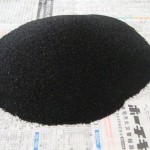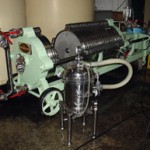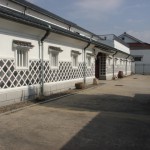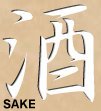The concept of “filtering” in sake can be a slightly confusing one. One reason is that, at least in English, sake is filtered a couple of times.
For example, as most readers surely recall, sake is made by a process in which rice  dissolves and its starch gets converted into sugar, and at the same time in the same tank a separate process is also taking place – that of yeast converting that sugar to alcohol. So starch-to-sugar and sugar-to-alcohol happen in parallel. What this also means is that when fermentation is complete, we still have a bunch of rice solids in the tank, components of the rice that could not be converted into sugar-then-alcohol.
dissolves and its starch gets converted into sugar, and at the same time in the same tank a separate process is also taking place – that of yeast converting that sugar to alcohol. So starch-to-sugar and sugar-to-alcohol happen in parallel. What this also means is that when fermentation is complete, we still have a bunch of rice solids in the tank, components of the rice that could not be converted into sugar-then-alcohol.
So, that has to be filtered out. The mash is passed through a mesh of some sort – there are various methods – to hold back the solids and let the sake go through. So, it’s filtered. However, in the sake-brewing industry, a different word is used; this name for this process is translated as “squeezing” or “pressing.” And, in fact, many sake texts and articles in English also use the word pressing to talk about that first filtration of rice solids.
But there is a second filtration. After the sake has been pressed, and at some time during its maturation period, often it is mixed with a fine charcoal powder and/or diatomaceous earth, and after those particles settle out, it is passed through a series of paper filters to filter out the stuff they just put in.
The good news – and the reason they do this in the first place – is that these porous active charcoal particles absorb several things. These include elements that give a goldenrod color to sake, things that can contribute roughness to the flavor, and even some bacteria that would be detrimental to the stability of the sake.
Sometime about 40 to 50 years ago, some brewers began using this active charcoal, and the resulting clean and clear sake became popular. And as a result, most of the sake adopted the practice too. And it is a good one – it serves a purpose that leads to great sake. Of course, it can be overdone, and it can be done poorly. But when done right and in the proper measure, it is a good thing.
This step, by the way, is also a filtration, and this one is actually called as such by the brewing industry. Roka means filtration, and its opposite, muroka, means unfiltered in the sense that no powdered active charcoal was used.
 However, not all sake goes through this process. Not all sake needs to! It depends on the brewer, the method, the style of sake and even the water used. Some brew in a way that the sake comes out clear and clean, and simply do not need to do this step. Others prefer the goldenrod color deliberately avoid the charcoal. And others aim for a big, rougher, almost mineral-laced flavor and therefore omit this process.
However, not all sake goes through this process. Not all sake needs to! It depends on the brewer, the method, the style of sake and even the water used. Some brew in a way that the sake comes out clear and clean, and simply do not need to do this step. Others prefer the goldenrod color deliberately avoid the charcoal. And others aim for a big, rougher, almost mineral-laced flavor and therefore omit this process.
There are also other ways to filter: ceramic filtration system and other solid-state mechanical filtration systems can be used. So charcoal is not the only way to go, but it does seem to be the most powerful way to remove color and roughness.
So, muroka refers to sake that does not go through charcoal filtration. Note, though, that this is not a legally-defined term, so that there can be and is some variance on the usage of the term. And we just have to deal with that. But I digress.
Bear in mind, though, this important point: Muroka is not unequivocally better than its charcoal filtered counterpart. It might seem that way to some, right? Natural. Unfiltered. Unsullied. And it is surely marketed that way by some. But it is not true. Sure, there is plenty of great muroka out there. If part of the deliberate design of the product, it often contributes to character and enjoyableness. But the charcoal-filtration process is a very precise, delicate and craftsmanship-laden one that contributes to better sake. So both are great for what they are.
This is one of those things that concerns me in the sense that a misunderstanding could  hinder the growth of popularity of sake. It is like the thinking that says nama is better than pasteurized sake, or that aged is more special than young sake, or that junmai is better than non-junmai types (for any one of a myriad of silly reasons). Nama-sake (unpasteurized sake) is great! Aged sake can be fascinating and wonderful! And junmai-shu is without a doubt outstanding sake and an outstanding brewing philosophy! But these types are not at all unequivocally better than their (pasteurized, youthful, or added-alcohol) counterparts. Not at all.
hinder the growth of popularity of sake. It is like the thinking that says nama is better than pasteurized sake, or that aged is more special than young sake, or that junmai is better than non-junmai types (for any one of a myriad of silly reasons). Nama-sake (unpasteurized sake) is great! Aged sake can be fascinating and wonderful! And junmai-shu is without a doubt outstanding sake and an outstanding brewing philosophy! But these types are not at all unequivocally better than their (pasteurized, youthful, or added-alcohol) counterparts. Not at all.
And muroka sake is another one of these. Just because it says muroka on the label does not mean it is going to be … anything. It will not be better simply by virtue of that. It may not even be bigger or rougher. It might be – but nothing is guaranteed simply by virtue of the word muroka being present.
The best principle is of course to gather your own experience – try both and note your observations. You may end up preferring sake made using one method over sake made using the other. But chances are you will find that it depends much more on a dozen other things going on with the sake, and with your own preferences.
Sake Today – the world’s first sake-only magazine! Get yours today www.sake-today.com .





